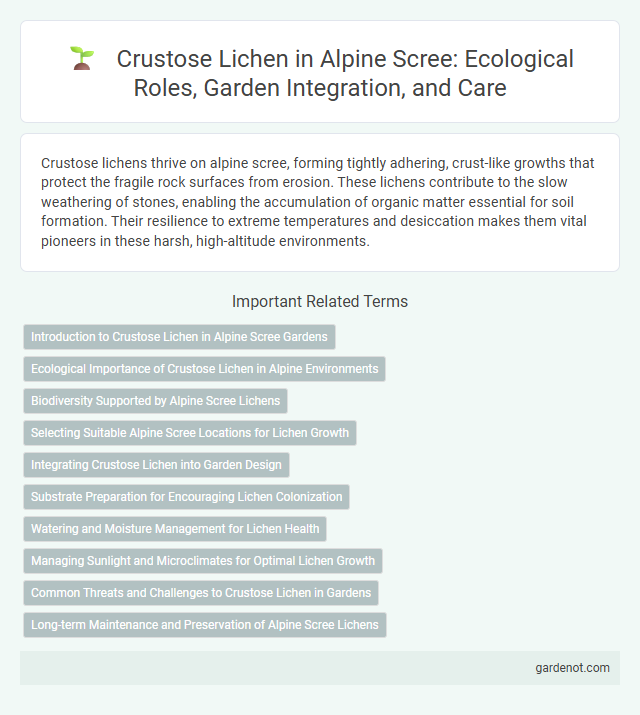Crustose lichens thrive on alpine scree, forming tightly adhering, crust-like growths that protect the fragile rock surfaces from erosion. These lichens contribute to the slow weathering of stones, enabling the accumulation of organic matter essential for soil formation. Their resilience to extreme temperatures and desiccation makes them vital pioneers in these harsh, high-altitude environments.
Introduction to Crustose Lichen in Alpine Scree Gardens
Crustose lichens in alpine scree environments exhibit a vital role in ecosystem stability by colonizing harsh, rocky substrates where few plants survive. These symbiotic organisms, composed of fungi and photosynthetic algae or cyanobacteria, form thin, crust-like layers that firmly adhere to scree surfaces, contributing to soil formation and nutrient cycling. Their resilience to extreme temperature fluctuations, UV radiation, and limited moisture makes crustose lichens essential pioneers in alpine garden succession.
Ecological Importance of Crustose Lichen in Alpine Environments
Crustose lichens play a crucial role in alpine scree ecosystems by stabilizing loose rock surfaces, reducing soil erosion, and facilitating soil formation through biological weathering. Their ability to survive extreme conditions enhances biodiversity by providing microhabitats and nutrient inputs in nutrient-poor environments. These lichens contribute to the ecological succession process, enabling colonization by other plant species and supporting overall alpine habitat resilience.
Biodiversity Supported by Alpine Scree Lichens
Crustose lichens in alpine scree environments contribute significantly to biodiversity by providing essential microhabitats for various microorganisms and invertebrates. These lichens stabilize the rocky substrate, facilitating soil formation and enabling colonization by other plant species. Their presence enhances ecosystem resilience and supports intricate biological networks in harsh alpine conditions.
Selecting Suitable Alpine Scree Locations for Lichen Growth
Crustose lichens thrive on stable, nutrient-poor alpine scree surfaces with minimal soil development, where exposure to sunlight and moisture is optimal for photosynthesis. Selecting suitable alpine scree locations involves identifying areas with well-drained substrates, typically composed of fine, angular rock fragments that retain moisture without promoting excessive erosion. Monitoring microclimatic conditions such as temperature fluctuations and wind exposure enhances the likelihood of successful crustose lichen colonization in these high-altitude environments.
Integrating Crustose Lichen into Garden Design
Crustose lichen thrives on the rocky surfaces of alpine scree, offering a natural, textural element ideal for garden design that emphasizes rugged, low-maintenance landscapes. Integrating crustose lichen into garden projects enhances biodiversity by supporting microhabitats while contributing subtle hues and patterns that blend seamlessly with stone and gravel features. Selecting native alpine crustose lichens ensures ecological harmony and durability in harsh, sun-exposed environments, making them perfect for sustainable rock garden aesthetics.
Substrate Preparation for Encouraging Lichen Colonization
Crustose lichens thrive on well-prepared substrates that offer stable, nutrient-poor surfaces typical of alpine scree environments. Surface stabilization through minimal soil disruption enhances photobiont attachment and mycobiont growth, critical for successful lichen colonization. Acidic, siliceous rocks provide optimal pH and mineral composition, promoting crustose lichen establishment and biodiversity.
Watering and Moisture Management for Lichen Health
Crustose lichens on alpine scree require precise watering to maintain optimal moisture without oversaturation, as excessive water can lead to fungal growth and damage. Natural precipitation patterns typically suffice, but during extended dry periods, gentle misting replicates dew and supports photosynthetic activity. Proper moisture management promotes lichen resilience and sustains their critical role in alpine ecosystem stability.
Managing Sunlight and Microclimates for Optimal Lichen Growth
Crustose lichens on alpine scree expertly regulate their exposure to intense sunlight by colonizing shaded microhabitats formed by rocks and crevices, promoting optimal photosynthesis while preventing desiccation. These lichens benefit from microclimates with moderated temperature fluctuations and moisture retention, essential for their metabolic processes and growth stability. Effective management of sunlight through natural shading and microtopography directly influences the distribution and health of crustose lichen communities in harsh alpine environments.
Common Threats and Challenges to Crustose Lichen in Gardens
Crustose lichen in alpine scree environments face threats from habitat disturbance caused by trampling and soil compaction, which disrupt their slow-growing surfaces. Air pollution, particularly sulfur dioxide and nitrogen oxides, adversely affects their photosynthesis and reproduction, leading to population declines. In gardens, challenges include competition from invasive plant species and chemical runoff from fertilizers and pesticides that alter substrate chemistry, hindering crustose lichen colonization.
Long-term Maintenance and Preservation of Alpine Scree Lichens
Crustose lichens play a critical role in the long-term maintenance and preservation of alpine scree ecosystems by stabilizing loose rock fragments and reducing soil erosion in harsh mountain environments. Their slow growth rates and resilience to extreme temperature fluctuations contribute to the gradual development of microhabitats essential for biodiversity in alpine zones. Conservation efforts prioritize monitoring these lichens to safeguard ecosystem functions against climate change and human disturbances.
Crustose lichen Infographic

 gardenot.com
gardenot.com